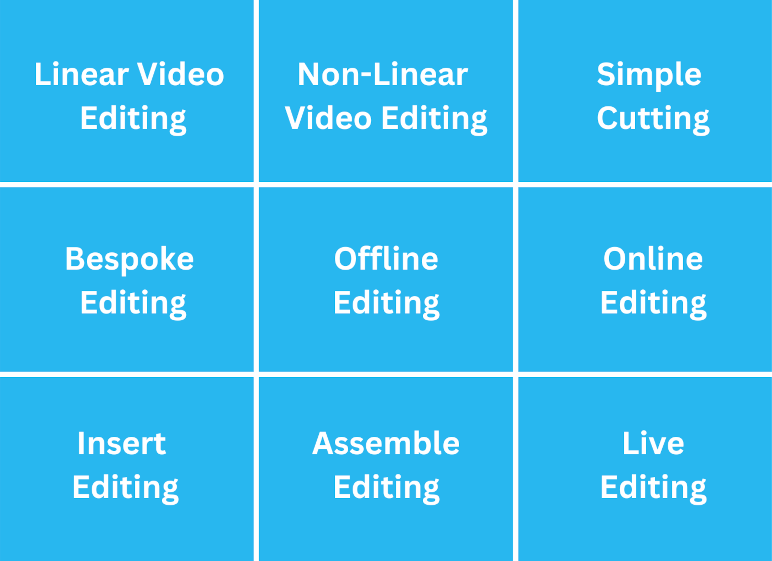Our content is reader supported, which means when you buy from links you click on, we may earn a commission.
9 Different Types of Video Editing

Video is popular. It’s so popular that according to Statista in 2020, over 83% of U.S. internet users access video while online.
As a video creator, if you’re going to take the time to create a video, you want your viewers to watch it the whole way through. You don’t want them to pause it halfway and scroll down to watch something different!
Videos that don’t tell a coherent story and include a lot of errors are hard to watch. That’s why the ability to edit a video can make a big difference in how it turns out.
In this guide, we’ll explore several types of video editing and look at the pros and cons of each type.
Whether you’re just getting started with video editing or are looking to expand your skillset, read on! You will find this article very helpful.

1. Linear Video Editing
Linear editing is a type of editing where the footage is arranged in a linear sequence, meaning that they are ordered chronologically. This was the standard method of editing for many years, but it has since been replaced by non-linear editing.
However, linear video editing is still used in some cases, such as when working with linear videotape or when creating a linear timeline of events.
Despite the advances in non-linear editing, linear video editing remains an important part of the video editing process.
Linear editing is also sometimes referred to as “linear sequence editing.” Linear video editing has a number of advantages which you can see here:
- It is very efficient and straightforward.
- It allows the editor to easily see the entire project at once and make changes as needed.
- Linear video editing can be used with a variety of different software programs.
There are also some disadvantages to linear video editing too including the following:
- It can be more time-consuming than non-linear editing.
- It can be difficult to make changes to the sequence once it has been edited.
2. Non-Linear Video Editing
Non-linear editing is a term used to describe the process of editing video footage that is not stored in a linear fashion. This type of editing allows for more flexibility and creativity, as it is not limited by the sequence of the footage.
Non-linear video editors typically provide a timeline interface that allows the user to manipulate the footage in any order they choose. This type of editing is essential for creating complex video projects, such as music videos or commercials.
Non-linear video editing can be a bit more challenging to learn than linear editing, but it provides a much greater degree of control over the final product.
Here are a few popular non-linear video editing tools:
- Pros: Used in professional settings; many powerful features; works on Macs and Windows machines.
- Cons: Can be complicated to learn; can be expensive.
- Pros: Widely used in professional settings; many powerful features.
- Cons: Can be expensive; can be difficult to learn for beginners; only works on Macs.
- Pros: Widely used in professional settings; many powerful features; relatively affordable.
- Cons: Can be difficult to learn for beginners.
3. Simple Cutting
Simple cutting is a type of video editing where you cut out sections of the video you don’t want and put the remaining pieces together. It’s a simple process, but it can be very effective if done correctly.
Here are a few things to keep in mind when doing simple cutting:
- Make sure that the cuts are clean and precise. Rough cuts will make the final product look amateurish. But when the cutting is properly done, the end product will not only be clean but also professional.
- Try to keep the number of cuts to a minimum. Too many cuts can be distracting and take away from the overall message of the video. This can undermine the purpose for which the video was created. It portrays unprofessionalism if the cuttings are not properly done.
- Pay attention to the audio. Make sure that the audio matches the visuals and that there are no gaps or jarring changes between sections.
4. Bespoke Editing
Bespoke editing is a process where a video is edited to suit the specific requirements of the client. In instances where you’re not the video creator, but are helping them, then this is likely what you’re doing.
If you are the video creator, then you may need to hire bespoke editing to get your video footage up to your level. This can include anything from changing the length of the video to adding or removing footage.
Bespoke editing is often used for corporate videos, training videos, and product demonstrations. It can also be used for personal projects, such as wedding videos and family albums. Bespoke video editing gives the client complete control over the final product, ensuring that it meets their exact needs and specifications.
5. Offline Editing
Offline editing is a process where video footage is transferred from a camera or other recording device to a computer for editing. The advantage of offline editing is that it allows for more complex and time-consuming editing tasks to be completed, without the need for real-time playback.
Offline editors can also take advantage of powerful computer graphics and special effects programs that would be too resource-intensive to use in real time.
The downside of offline editing is that it requires a bit more time and effort to set up, and the edited footage must be exported back to a format that can be played back on a television or other screen. However, for many video editors, the benefits of offline editing outweigh the drawbacks.
6. Online Editing
Online video editing is often done through an application that resides online. ClimpChamp, Veed.io, and many other tools are available to you (usually through a monthly subscription) to use for editing your videos.
Most online video editors will allow you to trim and crop your footage, add titles and effects, and even export your video in a variety of formats. If you’re just getting started with an online video editing program, there are a few things you should keep in mind:
- Make sure you have a good internet connection. Video files can be large, and you’ll need a fast connection to avoid any delays or disruptions while editing.
- Take some time to familiarize yourself with the interface of your chosen video editor. Online video editors can vary greatly in terms of usability, so it’s important to find one that’s easy for you to use.
- Don’t be afraid to experiment with the different features and tools available.
7. Insert Editing
Insert editing is a method of inserting a new video over an existing one with a clear beginning and endpoint. You can also add a new picture while keeping the original audio track.
In addition, insert video editing can be used to add special effects or titles to your videos. While it may take some practice to master insert video editing, it is a valuable skill that can help you create better videos.
8. Assemble Editing
Assemble editing is a process of putting together video footage to create a new video. This can be done by combining different scenes from different videos, or by adding new footage to an existing video.
Assemble editing can be used to create new stories or to change the meaning of an existing story. It can also be used to add new visual elements to a video or to remove unwanted elements. Assemble editing is a powerful tool that can be used to create new and exciting videos.
9. Live Editing
Live editing is the process of editing video in real time. It is often used in newsrooms and other live settings where it is important to get the video edited and ready for broadcast quickly.
Live editing can be done using software such as Adobe Premiere Pro, Final Cut Pro, and Avid Media Composer.
The editor will typically have a control room where they can see all of the different video feeds and make changes to them in real time. Live editing is a complex process that requires a lot of skill and experience. However, it can be very rewarding, especially when the finished product is aired on television or online.
FAQs on Types of Videos
What are the 5 stages of video editing?
The 5 stages of video editing are: importing, selecting, putting together, polishing, and exporting.
- Importing is the first stage and involves transferring your video footage from its original format onto your computer. This is usually done by connecting your camera to your computer using a USB cable.
- Once your footage is on your computer, you can start selecting which pieces you want to use in your final video. This involves watching all of your footage and choosing the best takes. You can then trim down each scene so that only the best parts are used.
- The next stage is putting together all of the selected footage into one cohesive video. This is done by adding transition effects between scenes and adding titles and credits.
- After your video is put together, you can start polishing it up with some additional effects. This may include color correction, audio enhancement, or special effects.
- Finally, once you’re happy with your video, you can export it in the desired format. This will allow you to watch it on your computer or share it online.
What is the 321 rule in video editing?
The 321 rule in video editing is a guideline that says you should have 3 shots for every 1 second of video. This means that if you’re editing a 10-second clip, you should have 30 total shots.
The idea behind the 321 rule is that it helps to keep your videos interesting and engaging by giving the viewer a variety of different visual elements to look at. It can also help to tell a story or communicate a message more effectively.
While the 321 rule is a helpful guideline, it’s not set in stone. You may need to use more or fewer shots depending on the specific video you’re working on.
What is the best video editing program?
Video editing equipment can be expensive, but you may already have most of it if you already have a computer. In that case, you’ll likely still need to invest in a video editing program.
The best video editing programs are easy to use and have a user-friendly interface. They should also have a wide range of features and tools you can use to edit your videos and be compatible with a variety of different file formats.
Based on these criteria, we believe that the best video editing program is Adobe Premiere Pro. It ticks all the boxes in terms of usability, features, and compatibility, and it’s also relatively affordable compared to some of the other options out there.
What is a good beginner’s video editing program?
If you’re not sure where to start, some good beginner video editing programs include Adobe Premiere Elements and Apple iMovie.
What’s Next?
Video is so popular that according to HubSpot in 2018, 54% of online users want to see more videos from the businesses they frequent.
You want to get your videos in front of your audience and keep them watching the whole way through. Editing your video can be the difference between a good and a great final product that is watched to the end.
The types of video editing covered in this guide will help you refine your video to near perfection.
Hopefully, this has given you some ideas on new methods for editing your videos.